Peru Diary 7
Oct 13
A day of travelling, or rather a day of waiting as there was a five
hour gap between flights at Lima airport en route to Iquitos. This is
apparently due to the lack of day-time flights to Iquitos when the
airspace over the Amazon is given over to vultures. This turned into a
slightly longer wait, as the flight to Iquitos was delayed due to the
flight crew being trapped in a lift in the airport! The arrival of the
fire brigade in heavy protective gear and helmets provided a little
entertainment & shortly afterwards the crew appeared. They ought to
have looked harassed and stressed, but strode through the waiting
passengers with the usual air of confident superiority.
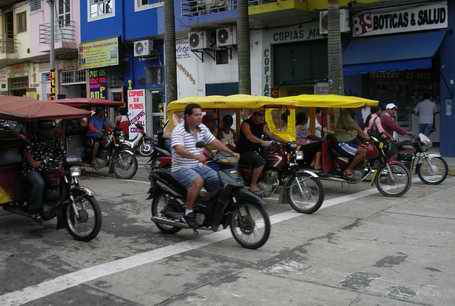 The drive from Iquitos
airport was marked by two things. Firstly, coping with the sudden rise
in heat and humidity that first struck us as we stepped off the plane.
Secondly, trying to recognise anything as being in the same
country, Peru, that we had just left in Lima - everything seemed
different here, and more like Asia. Perhaps this was mainly due to the
huge numbers of motorbike taxis everywhere - the roar of motor-bikes
carried on late into the night. It is obviously not just visitors who
notice the noise for there were placards everywhere urging a war on
noise, and advertising a ten minutes silence next week.
The drive from Iquitos
airport was marked by two things. Firstly, coping with the sudden rise
in heat and humidity that first struck us as we stepped off the plane.
Secondly, trying to recognise anything as being in the same
country, Peru, that we had just left in Lima - everything seemed
different here, and more like Asia. Perhaps this was mainly due to the
huge numbers of motorbike taxis everywhere - the roar of motor-bikes
carried on late into the night. It is obviously not just visitors who
notice the noise for there were placards everywhere urging a war on
noise, and advertising a ten minutes silence next week.
The hotel was constantly invaded by t-shirt sellers, who displayed
their wares outside the reception windows like like temporary curtains.
Go, go, go at traffic lights in
Iquitos
Oct 14
We were collected by bus in the morning to drive to Bellavista, the
market, port and village on stilts at the junction of the Manay and
Amazon rivers. From here we were taken on a speedboat ride up the
winding Manay river and into a tributary to visit the same Bora tribe
that I visited with the last group. This time we learnt that this
village was set up by an enterprising ex-army Bora guy whose family had
moved into the area to escape persecution elsewhere. They actually live
in a nearby village, but have set up this show village to demonstrate
the tribal culture. All the extended family between the ages of 10 and
40 looked bored during the dances, but the toddlers enjoyed it! After
purchasing bits of Anaconda vertebrae jewellery, bark skirts and
pictures and blow-pipes we set off back down the river for the 40 km
ride down the Amazon to Heliconia Lodge.
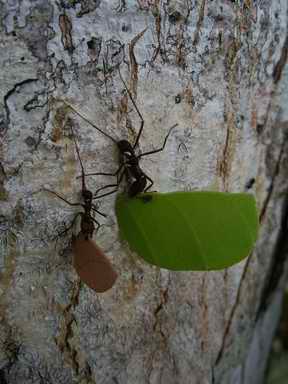
The lodge was a rustic construction on stilts (as the Amazon floods the
whole area in the wet season), with a resident bird, Pedro, bunches of
bananas hanging and hurricane lamps on the walkways, hammocks in the
bar and a nearby snoozing room - what more could you want? It is
reached up the steep collapsing river banks by wooden walkway and tree
stumps set into the earth. The food was excellent and usually had some
local vegetable such as palm hearts and cassava/yuca as well as daily
rice and beans. The fish was always tasty...especially when the next
day we ate the piranhas caught during the morning fishing session!

The afternoon was spent on a jungle walk, with plenty of interesting
insects, birds, flowers, fungi and one performing sloth (i.e. it moved,
slowly) on display. We had had rain in the morning in Iquitos, and
there were still impressive storm clouds around. This led to a
colourful sunset, and later when we went for a night boat trip to
listen to the sounds of the Amazon, to distant illuminations as
lightning flashed within the clouds.
Leaf-cutter
ants at work
Sunset on the Amazon
Oct 15
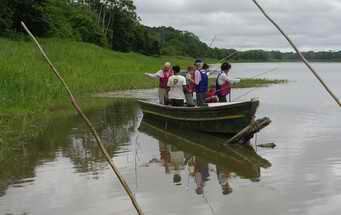
The day started for us just after dawn with a boat trip up a nearby
creek to look for birds. We did not need to look much, as they were
everywhere , from parrots screaming overhead to the roadside hawk
looking disdainfully on our party. The guide, Victor, did a great
job of identifying the minutest of sightings and mimicking many of
them. Perhaps the most spectacular fly-past was, however, a
metallic blue butterfly that flashed past us as we were gliding
silently up the creek.
After breakfast we had the serious task of fishing to attend to - just
a stick, some line and meat on a hook was all that the guide and
boatmen needed to haul fish after fish, piranhas and sardines, out of
the shallow reedy water. It didn't seem to work as well for us, but
nevertheless we had a reasonable haul between us. The large ones were
kept, but the majority were returned to the water. We then went
on a river dolphin hunt, which was successful in the sense that we had
some evidence that there were some there - but a bit of pink slightly
breaking the water wasn't the sort of sighting we had envisaged - too
many water world displays or nature TV programmes somewhat raises ones
expectations.....
Serious fishing
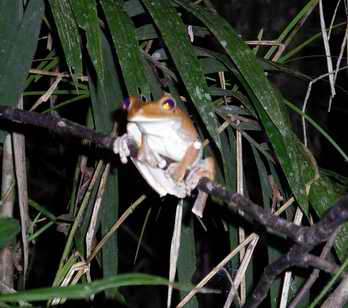
After dark it was out with the torches and off down the walkways into
the jungle to see what might be hiding there - we heard plenty, but saw
little. However, a very hairy tarantula and a cute tree frog made it
worthwhile!
Tree
Frog
Oct 16
Already it was our last day here - back to 'civilisation' in the
evening. A hardy ten set off at dawn again to bird-watch. This time on
the island across the river, and the bird count was even bigger than
the previous day - my stars being the little bright red birds, the
masked crimson tanagers, that were chasing around the foliage as we sat
by a lake covered in water lettuce watching the jacanas striding from
leaf to leaf. (Here's a list for anyone
interested!)
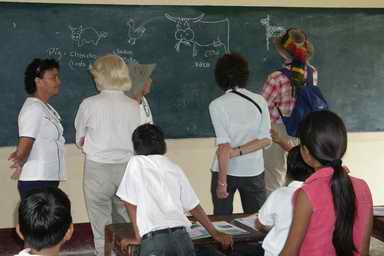
After breakfast we were taken by Victor to the Yanamono Community
School, as he had some pens and paper donated by a Canadian person to
give to the school. We went from class to class, starting at the
nursery. At the third class, the last before the secondary school, we
listened while the children sang a song of greeting. We got our own
back by singing "Old MacDonald had a farm", complete with actions and
then with illustrations drawn by Ewan on the blackboard - enabling the
children to join in with the actions when we were persuaded to repeat
the song. Having caused chaos in these 3 classes we had a quick
introduction to the headteacher & two secondary teachers who were
sheltering in the diminutive head's study/office/staff room where the
radio was competing with the teachers' answers to our questions.
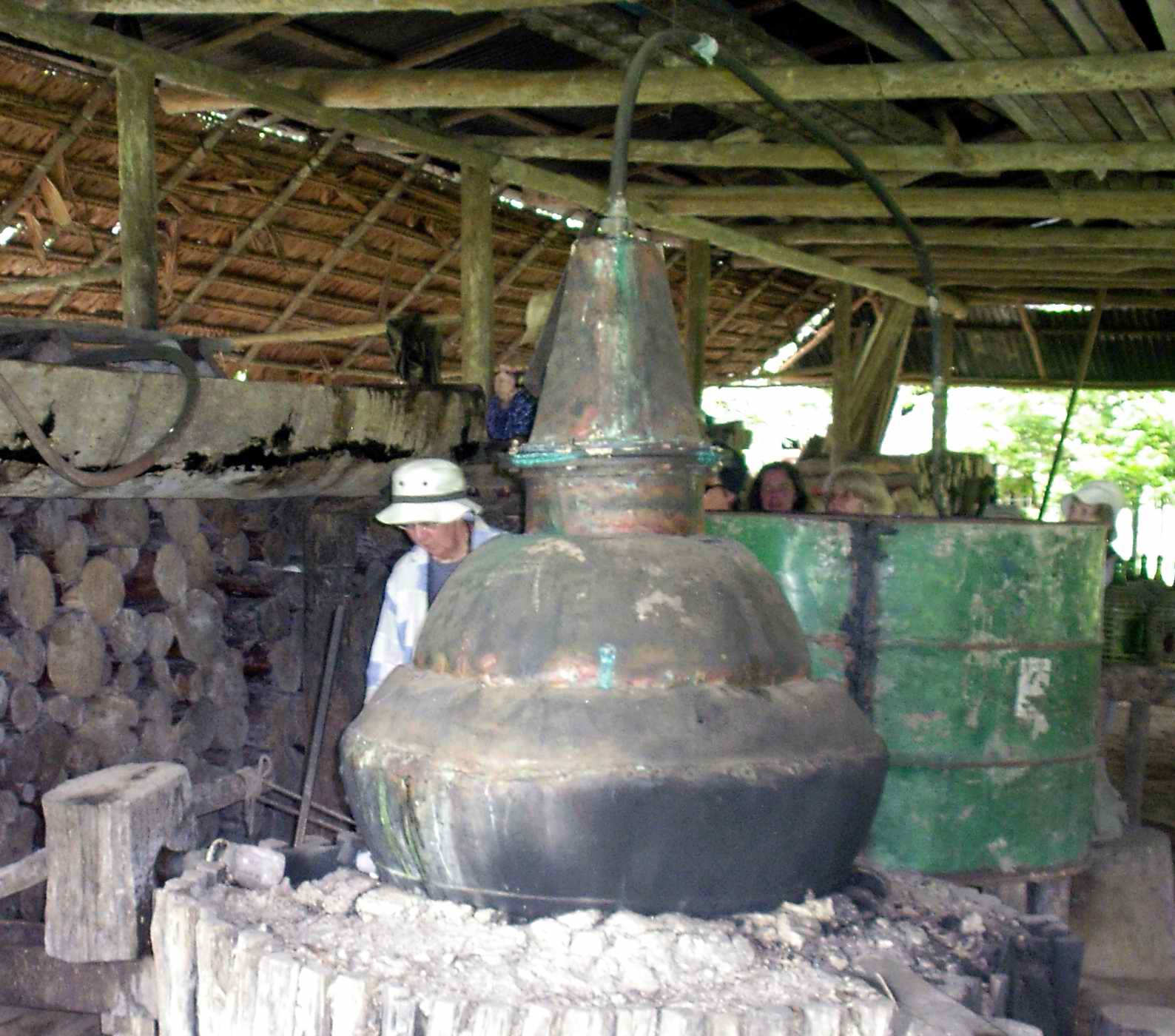
Ewan illustrates "Old MacDonald had a
farm"
From Education we switched to Intoxication by visiting a nearby sugar
plantation with its sugar extracting machinery, - horse powered and
over 100 years old - fermentation dug-out 'canoe', and still. There
followed the customary tasting of the raw fire-water and 3 variants
including ginger and '7 roots' flavours. The plain syrup on scraps of
bread was very pleasant. We were then permitted to nose around the
house itself, a wooden hut on stilts with a walkway to the separate
kitchen area - double the size of my kitchen, but somewhat more basic...
After lunch it was back in the speedboat & back to Iquitos to catch
the sunset flight back to Lima - back to the cool & grey!
Rustic
still on sugar plantation
Oct 17
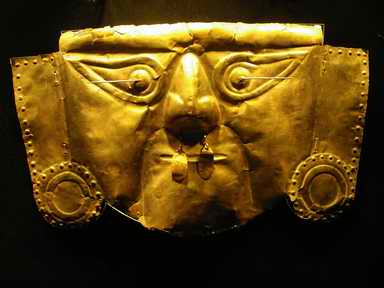 The last full day of the tour
for the group began with a coach tour that rapidly took in the Parque
del Amor on the cliffs, the pre-Inca temple of Huaca Pucllana, the
original olive groves of San Isidro, now sprinkled with elegant houses
and surrounded by development and ended in Lima centre where we visited
the San Francisco Monastery and the Cathedral before lining up outside
the Presidential Palace to watch the changing of the guard. It was hard
to take the event seriously when the brass band was playing El Condor
Paso very slowly, and the flag carrying soldiers were doing a
slow-motion goose step forwards, backwards and sideways that Nureyev
would have been proud of...
The last full day of the tour
for the group began with a coach tour that rapidly took in the Parque
del Amor on the cliffs, the pre-Inca temple of Huaca Pucllana, the
original olive groves of San Isidro, now sprinkled with elegant houses
and surrounded by development and ended in Lima centre where we visited
the San Francisco Monastery and the Cathedral before lining up outside
the Presidential Palace to watch the changing of the guard. It was hard
to take the event seriously when the brass band was playing El Condor
Paso very slowly, and the flag carrying soldiers were doing a
slow-motion goose step forwards, backwards and sideways that Nureyev
would have been proud of...
After this, and a good value lunch in a restaurant near the Plaza de
Armas, we were whisked off to the Archaeological museum for a rapid
tour, backwards, of the Peruvian civilisations that pre-dated the
Incas. The guide, Ricardo, obviously knew the collection inside out and
was quite good at maintaining a link between the exhibits despite the
usual postprandial torpor setting in for most of us! The odd thing that
came out was that the beauty and delicacy of the pottery seemed to get
better as the objects got older, until the best items were reached over
a thousand years before the Inca civilisation. I will remember the
'stirrup-shaped' vessels that were found in all the periods, indicating
a cultural connection between the tribes.
On the pottery, and on the gold masks, the representations of faces -
sometimes realistic, sometimes stylised, were remarkably expressive.
Gold funerary mask
After dinner a few of us ventured out to the Parque Centrale,
where not only is there a craft market in the evenings, but in a small
amphitheatre there is sometimes music and dancing. Although we were too
late to see any live singing the Latino-American disco music was in
full throb and the centre of the ring was full of (mainly) 50+
year-olds dancing away. there was a good crowd watching - that's where
the young people were!
Oct 18
The day of departure for the Ramblers group, but not until the evening,
so everyone had free time to explore locally - some hitting the coast
& heading north or south (or just staying in the Larcomar centre),
and some heading off to the Huaca Pucllana. Meanwhile I moved from the
luxury of the hotel to a hostel on Avenida Arequipa where,
surprisingly, my little whitewashed room did not have a jacuzzi!
After
seeing the group off to the airport I took a taxi back to the Central
Park in Miraflores, where I found music and dancing in full swing again
in the little amphitheatre. At one point two couples dressed stylishly
(suits & hats for the men, long white dresses for the women) came
on and danced a beautiful flirting dance that was a cross between
flamenco and a stand-off bull fight! So beautiful in fact that the
dance was repeated with slight variations, to the same music, four
times! The audience participated with syncopated clapping and
much enthusiasm. What a great place!
Back to Peru Trip Index

 The drive from Iquitos
airport was marked by two things. Firstly, coping with the sudden rise
in heat and humidity that first struck us as we stepped off the plane.
Secondly, trying to recognise anything as being in the same
country, Peru, that we had just left in Lima - everything seemed
different here, and more like Asia. Perhaps this was mainly due to the
huge numbers of motorbike taxis everywhere - the roar of motor-bikes
carried on late into the night. It is obviously not just visitors who
notice the noise for there were placards everywhere urging a war on
noise, and advertising a ten minutes silence next week.
The drive from Iquitos
airport was marked by two things. Firstly, coping with the sudden rise
in heat and humidity that first struck us as we stepped off the plane.
Secondly, trying to recognise anything as being in the same
country, Peru, that we had just left in Lima - everything seemed
different here, and more like Asia. Perhaps this was mainly due to the
huge numbers of motorbike taxis everywhere - the roar of motor-bikes
carried on late into the night. It is obviously not just visitors who
notice the noise for there were placards everywhere urging a war on
noise, and advertising a ten minutes silence next week.





 The last full day of the tour
for the group began with a coach tour that rapidly took in the Parque
del Amor on the cliffs, the pre-Inca temple of Huaca Pucllana, the
original olive groves of San Isidro, now sprinkled with elegant houses
and surrounded by development and ended in Lima centre where we visited
the San Francisco Monastery and the Cathedral before lining up outside
the Presidential Palace to watch the changing of the guard. It was hard
to take the event seriously when the brass band was playing El Condor
Paso very slowly, and the flag carrying soldiers were doing a
slow-motion goose step forwards, backwards and sideways that Nureyev
would have been proud of...
The last full day of the tour
for the group began with a coach tour that rapidly took in the Parque
del Amor on the cliffs, the pre-Inca temple of Huaca Pucllana, the
original olive groves of San Isidro, now sprinkled with elegant houses
and surrounded by development and ended in Lima centre where we visited
the San Francisco Monastery and the Cathedral before lining up outside
the Presidential Palace to watch the changing of the guard. It was hard
to take the event seriously when the brass band was playing El Condor
Paso very slowly, and the flag carrying soldiers were doing a
slow-motion goose step forwards, backwards and sideways that Nureyev
would have been proud of...